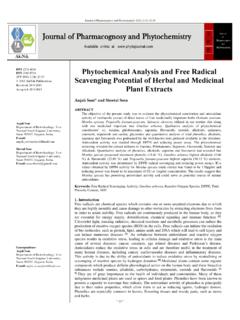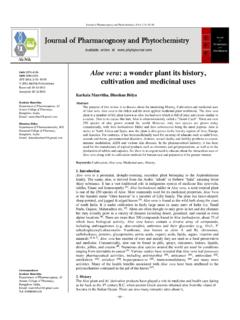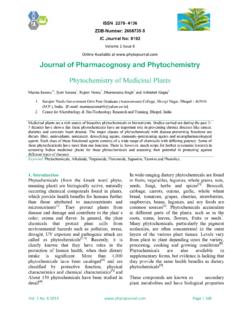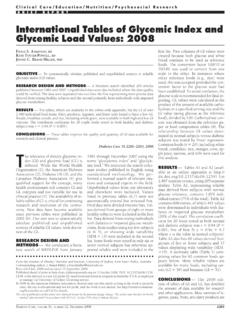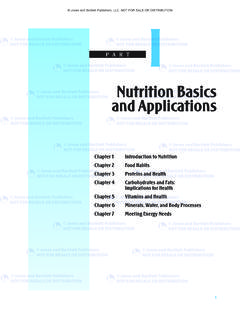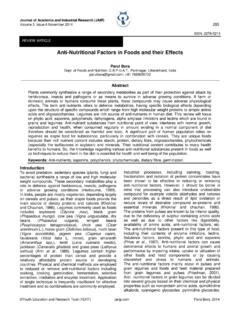Transcription of Nutritional components in green leafy vegetables: A review
1 ~ 2498 ~ Journal of Pharmacognosy and Phytochemistry 2020; 9(5): 2498-2502 E-ISSN: 2278-4136 P-ISSN: 2349-8234 JPP 2020; 9(5): 2498-2502 Received: 15-06-2020 Accepted: 20-08-2020 Deepak Kumar Department of Agriculture, Moradabad, Uttar Pradesh, India Satendra Kumar University of Agriculture & Technology, Uttar Pradesh, India Chandra Shekhar Gochar Mahavidhayalaya Rampur Maniharan Saharanpur Uttar Pradesh, India Corresponding Author: Deepak Kumar Department of Agriculture, Moradabad, Uttar Pradesh, India Nutritional components in green leafy vegetables: A review Deepak Kumar, Satendra Kumar and Chandra Shekhar Abstract green leafy vegetables have generated interest worldwide as they exhibit multiple benefits for health of human beings.
2 This paper reviews the literature on Nutritional components in some important frequently green leafy vegetables. green leafy vegetables are major components of a healthy diet, and their sufficient daily consumption could help prevent major diseases. These vegetables may help to meet daily requirements of these and other essential nutrients, especially in individuals with marginal Nutritional status. Vegetables can form the cheapest and most readily available sources of important fibers, vitamins, minerals, essential amino acids and substances that help protect you from disease particularly. The type and composition of Nutritional components vary among genera and species of different edible leafy vegetables plants.
3 The aim is to evaluate the Nutritional value of these plant species and their potential impact on the Nutritional status. The low caloric value of leafy vegetables makes them ideal for weight management and these are a rich source of nutrients, high in dietary fiber, low in lipids, and rich in foliate, vitamin C (ascorbic acid), vitamin K (phylloquinone), magnesium, and potassium. Mineral nutrients like iron and calcium are high in leafy vegetables than staple food grains. Also, leafy vegetables are the only natural sources of folic acid, which are considerably high in leaves of spinach, asparagus, lettuce, mustard green , colocasia green leaf and turnip green plants as compared to other leafy and non- leafy vegetables.
4 The consumption, cultivation and possibly the commercialization of these leafy vegetables should therefore be promoted. Keywords: Nutritional components , green leafy vegetables, proteins, vitamins, minerals Introduction green leafy vegetables occupy an important place among the food crops as these provide adequate amounts of many vitamins and minerals for humans. They are rich source of vitamins like beta-carotene, ascorbic acid, riboflavin, folic acid and minerals like calcium, iron, phosphorous etc. In nature, there are many underutilized greens of promising nutritive value, which can nourish the ever increasing human population.
5 green leafy vegetables are of importance to the nutrition of the populations especially in the developing countries. India being blessed with a variety of natural surroundings, varying climates and seasons, has a varied species of leafy vegetables. A large number of leaves from different sources such as perennial trees, aquatic plants and annuals are consumed. Some of the commonly consumed leafy vegetables are spinach (Spinacia oleracea), amaranth (Amaranthus gangeticus), fenugreek (Trigonella foenum graecum), drumstick (Moringa oleifera), cabbage (Brassica oleracea var. capitata), bathua (Chenopodium album), etc.
6 These greens are inexpensive, high yielding, a part of the local diet and often easily available. Some of the greens are also used as leafy spices because of their flavour such as curry leaf (Murraya koenigii), coriander leaves (Coriandrum sativum), mint (Mentha spicata), bay leaf (Laurus nobilis), basil (Ocinum basilicum), etc. Normally, vegetables are widely designated as protective foods in human diet due to their varied health benefits attributable to the richness in vitamins, essential fatty acids, minerals, amino acids and dietary fiber and various essential bioactive compounds. There is also growing ignorance among young people about the existence of these readily available nutritionally rich food plants [35].
7 They are very important protective foods and useful for the maintenance of health and for prevention of various diseases [12]. Apart from the variety which they add to the menu [2, 7], they are valuable sources of nutrients especially in rural areas where they contributes substantially to minerals, vitamins, fibers, proteins and other nutrients which are usually in short supply in daily diets. leafy vegetables have low energy densities thus recommended for weight management [33]. Vitamins are important for human health and among the vitamins, vitamin C is an essential micronutrient required for normal metabolic functions of the body.
8 Vitamin C plays an important role as a component of enzymes involved in the synthesis of collagens and carnitine. Vitamin C is the major water-soluble antioxidant in the human body. ~ 2499 ~ Journal of Pharmacognosy and Phytochemistry green leafy vegetables contains numerous minerals such as iron (Fe), calcium (Ca), phosphorus (P), Copper (Cu), Zinc (Zn), Sodium (Na) and chloride (Cl) which have vital for growth, metabolism etc (table 1). The predominant elements found in green leafy vegetables are iron (Fe), calcium (Ca), potassium (K), sodium (Na) etc. Dark lettuces are rich in vitamins A, C and K; eating them regularly will improve your eyesight, bone health and skin elasticity while helping your blood to clot normally.
9 Spinach is one of the most nutritious foods available, as it is low in calories and high in vitamins; spinach is one of the most nutrient -dense foods in existence. It is packed with vitamins A and C, as well as foliate. Heat reduces the green s oxalate content, freeing up its dietary calcium [45], cooked spinach gives you more nutrition than raw, but is excellent eaten raw in salads. These include health-promoting plant secondary metabolites composed of antioxidants and phenolic compounds. WHO/FAO (2003) published a report recommends minimum of 400g of fruit and vegetables per day (excluding potatoes and other starchy tubers) for the prevention of chronic diseases such as heart disease, cancer, diabetes and obesity, as well as for the prevention and alleviation of several micronutrient deficiencies.
10 The dietary guidelines for Americans recommend five servings of vegetables per day based on an intake of 2000 calories (HHS/USDA, 2015). It is also recommended that one of the five servings of vegetables should be green leafy vegetables. Spinach and other green leafy vegetables are rich sources of foliate along with other vegetables, fruit, Brewer's yeast, legumes, and especially liver[31, 32]. Nutritionists and dieticians are of the opinion that people should diversify their diets as no single vegetable meets all the Nutritional requirements necessary for good health and wellbeing [3, 51].

